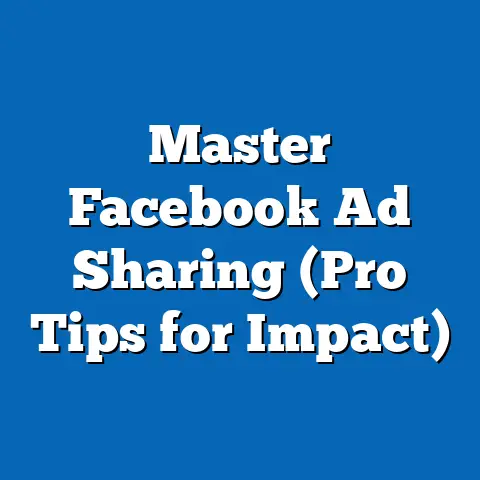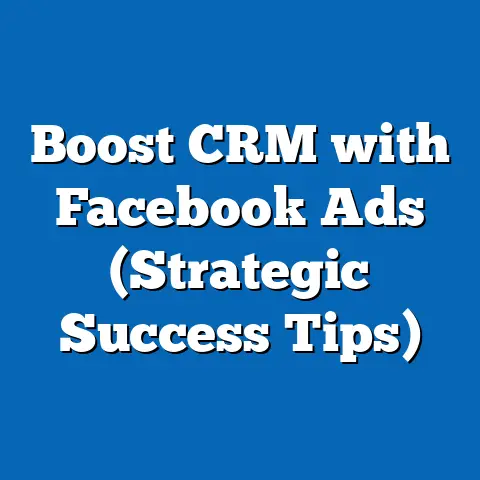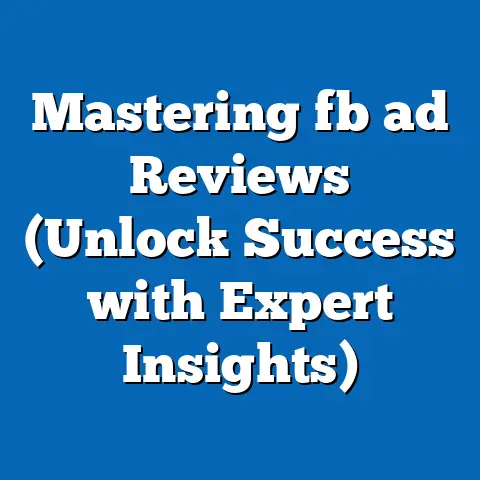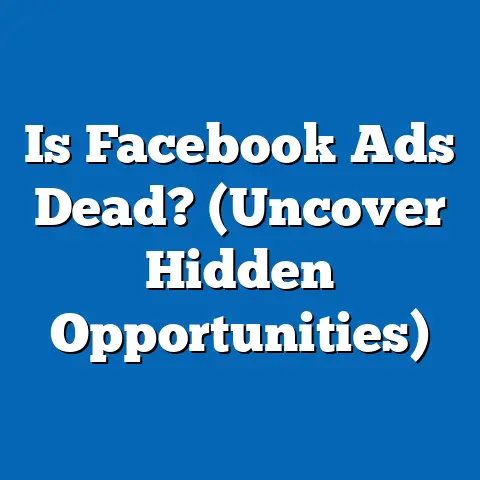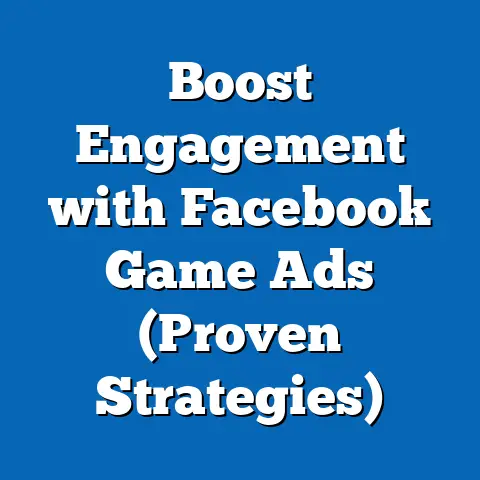Facebook Ad Format Showdown (Ultimate Guide for Success)
Facebook advertising. It’s a beast, isn’t it? I remember when I first started, I felt completely overwhelmed. But here’s the thing: it doesn’t have to be complicated. In today’s digital marketing arena, Facebook ads are a powerhouse. They offer an unparalleled opportunity to connect with a massive audience, drive brand awareness, and boost sales. But, let’s be honest, the options can be dizzying. From simple image ads to immersive instant experiences, the sheer variety of Facebook ad formats can leave even seasoned marketers scratching their heads.
That’s why I’m here! I’m going to break down the world of Facebook ad formats, focusing on those that are easy to manage yet highly effective. I’ll guide you through the best options, share real-world examples, and give you actionable strategies to create campaigns that actually deliver results. Get ready to discover how to leverage the power of Facebook ads without getting bogged down in complexity. This guide is your roadmap to Facebook advertising success, regardless of your experience level.
Overview of Facebook Ads
Let’s take a quick trip down memory lane. Facebook advertising has come a long way since its humble beginnings. I remember the early days when it was all about simple text ads and basic targeting. Now, it’s a sophisticated platform with a plethora of ad formats, advanced targeting options, and robust analytics.
Choosing the right ad format is crucial. It’s not just about aesthetics; it’s about aligning the format with your specific marketing objectives. Do you want to increase brand awareness? Drive traffic to your website? Generate leads? Each ad format has its strengths and weaknesses, and the right choice can significantly impact your campaign’s success.
The competition for attention on Facebook is fierce. Millions of businesses are vying for the same eyeballs, making it essential to stand out from the crowd. A well-crafted ad, using the right format and targeting, can cut through the noise and capture your audience’s attention. Think of it like this: you’re not just placing an ad; you’re starting a conversation.
Key Takeaway: Facebook advertising has evolved into a complex ecosystem, but choosing the right ad format is crucial for achieving your marketing goals and standing out from the competition.
Low-Maintenance Ad Formats
Let’s talk about the unsung heroes of Facebook advertising: the low-maintenance ad formats that deliver big results without requiring a ton of effort. These are the formats I often recommend to clients who are just starting out or who have limited resources.
Image Ads
Image ads are the bread and butter of Facebook advertising. They’re simple, effective, and versatile. I’ve seen countless businesses achieve impressive results with just a well-chosen image and compelling copy. The key is to use high-quality visuals that grab attention and convey your message clearly. Think about using bright colors, interesting compositions, and images that resonate with your target audience.
Image ads are suitable for a wide range of marketing goals, from increasing brand awareness to driving website traffic. They’re especially effective for showcasing products, promoting events, or sharing special offers.
Video Ads
Don’t let the word “video” scare you! Creating engaging video ads doesn’t have to be a Hollywood production. Short, simple videos can be incredibly effective on Facebook. I’m talking about 15-30 second clips that quickly capture attention and convey your message.
Video ads are perfect for telling stories, demonstrating products, or sharing testimonials. They tend to perform well on Facebook because they’re visually appealing and can hold viewers’ attention longer than static images. Tools like Canva and Animoto make it easy to create professional-looking videos without any prior experience.
Slideshow Ads
Slideshow ads are a fantastic way to create a video-like experience without the need for actual video footage. They allow you to combine multiple images and create a visually engaging presentation. I often recommend slideshow ads to businesses that have a lot of product images or want to showcase different aspects of their brand.
Slideshow ads are easy to create and manage. You can use existing images or create new ones using simple design tools. They’re also a great way to test different visuals and see what resonates best with your audience.
Example: A local bakery could use a slideshow ad to showcase their different pastries and cakes, highlighting the fresh ingredients and delicious flavors.
Key Takeaway: Low-maintenance ad formats like image ads, video ads, and slideshow ads can be highly effective for reaching your target audience and achieving your marketing goals without requiring extensive resources.
In-Depth Analysis of Facebook Ad Formats
Now, let’s dive deeper into the world of Facebook ad formats and explore some of the more advanced options. While these formats may require a bit more effort, they offer unique opportunities to engage your audience and drive results.
Carousel Ads
Carousel ads are a favorite of mine because they allow you to showcase multiple images or videos within a single ad unit. Users can swipe through the carousel to view different products, features, or aspects of your brand. I’ve seen carousel ads work wonders for e-commerce businesses looking to highlight their product catalog.
Carousel ads are ideal for:
- Showcasing multiple products or features
- Telling a story across multiple images or videos
- Driving traffic to specific product pages on your website
Example: A clothing retailer could use a carousel ad to showcase different outfits, each linking to the corresponding product page on their website.
Collection Ads
Collection ads are designed for e-commerce brands and integrate a carousel of products with a cover image or video. When users click on the ad, they’re taken to a full-screen Instant Experience showcasing your products. I often recommend collection ads to businesses that want to create a visually immersive shopping experience on Facebook.
Collection ads are perfect for:
- Showcasing a curated collection of products
- Driving traffic to your website or app
- Increasing sales and conversions
Example: A furniture store could use a collection ad to showcase a living room set, with each item in the set linking to its product page on their website.
Instant Experience Ads
Instant Experience ads (formerly known as Canvas ads) offer an immersive, full-screen experience within the Facebook app. They allow you to combine images, videos, text, and interactive elements to create a captivating ad experience. I’ve seen Instant Experience ads work wonders for brands looking to tell their story or showcase their products in a unique way.
Instant Experience ads are ideal for:
- Telling your brand story
- Showcasing your products in detail
- Creating an interactive and engaging ad experience
Example: A travel agency could use an Instant Experience ad to showcase a destination, with images, videos, and interactive maps that allow users to explore the location.
Lead Ads
Lead ads are designed to collect user information directly within Facebook, minimizing friction in the lead generation process. When users click on a lead ad, they’re presented with a form that’s pre-filled with their Facebook profile information. I often recommend lead ads to businesses that want to generate leads for their sales team or build their email list.
Lead ads are perfect for:
- Generating leads for your sales team
- Building your email list
- Collecting user information for market research
Example: A real estate agent could use a lead ad to collect information from potential homebuyers, such as their budget, desired location, and contact information.
Key Takeaway: Facebook offers a variety of ad formats, each with its unique strengths and weaknesses. Understanding the different formats and their ideal use cases is crucial for creating effective campaigns that achieve your marketing goals.
Strategies for Success
Choosing the right ad format is just the first step. To truly succeed with Facebook advertising, you need to optimize your campaigns for maximum impact. Here are some proven strategies that I’ve used to help my clients achieve impressive results:
A/B Testing
A/B testing involves creating multiple versions of your ad and testing them against each other to see which performs best. I always recommend A/B testing different ad formats, visuals, copy, and targeting options to identify the winning combinations.
Audience Targeting
Facebook’s audience targeting features are incredibly powerful. You can target users based on demographics, interests, behaviors, and more. I always emphasize the importance of defining your target audience and using Facebook’s targeting options to reach the right people with your ads.
Analytics and Insights
Facebook provides robust analytics and insights that allow you to track the performance of your ads and identify areas for improvement. I always encourage my clients to monitor their ad performance closely and use the data to refine their campaigns continuously.
Compelling Visuals and Persuasive Copy
No matter which ad format you choose, compelling visuals and persuasive copy are essential for capturing user attention and driving results. I always advise my clients to invest in high-quality visuals and craft compelling copy that speaks to their target audience.
Key Takeaway: Optimizing your Facebook ad campaigns through A/B testing, audience targeting, analytics, and compelling creative is crucial for achieving your marketing goals and maximizing your ROI.
Case Studies
Let’s take a look at some real-world examples of successful Facebook ad campaigns that utilized different ad formats effectively.
Case Study 1: E-commerce Brand Using Carousel Ads
An e-commerce brand selling handmade jewelry wanted to increase sales and drive traffic to their website. They created a carousel ad showcasing different pieces of jewelry, each linking to the corresponding product page on their website. The campaign resulted in a 30% increase in website traffic and a 20% increase in sales.
Lesson Learned: Carousel ads are highly effective for showcasing multiple products and driving traffic to specific product pages.
Case Study 2: Travel Agency Using Instant Experience Ads
A travel agency wanted to promote a destination and generate leads for their sales team. They created an Instant Experience ad showcasing the destination with images, videos, and interactive maps. The campaign resulted in a 50% increase in leads and a 25% increase in bookings.
Lesson Learned: Instant Experience ads are perfect for telling a story and creating an immersive ad experience that captivates users.
Case Study 3: Local Restaurant Using Lead Ads
A local restaurant wanted to build their email list and promote special offers. They created a lead ad offering a free appetizer to users who signed up for their email list. The campaign resulted in a 40% increase in email subscribers and a 15% increase in restaurant traffic.
Lesson Learned: Lead ads are a simple and effective way to collect user information and generate leads for your business.
Key Takeaway: These case studies demonstrate the power of Facebook advertising and the importance of choosing the right ad format for your specific goals.
Conclusion
Choosing the right Facebook ad format is crucial for achieving your marketing goals and maximizing your ROI. Whether you opt for the simplicity of image ads, the visual appeal of video ads, or the immersive experience of Instant Experience ads, understanding the strengths and weaknesses of each format is essential.
I encourage you to experiment with different ad formats, test different visuals and copy, and continuously optimize your campaigns based on performance data. The world of Facebook advertising is constantly evolving, so staying up-to-date with the latest trends and best practices is key.
Now it’s your turn! Take the insights you’ve gained from this guide and start creating Facebook ad campaigns that deliver results. Share your experiences in the comments below or on your own platforms. I’m excited to see what you achieve! And hey, if you need a little extra help, don’t hesitate to reach out. I’m always happy to share my knowledge and help businesses succeed with Facebook advertising.

